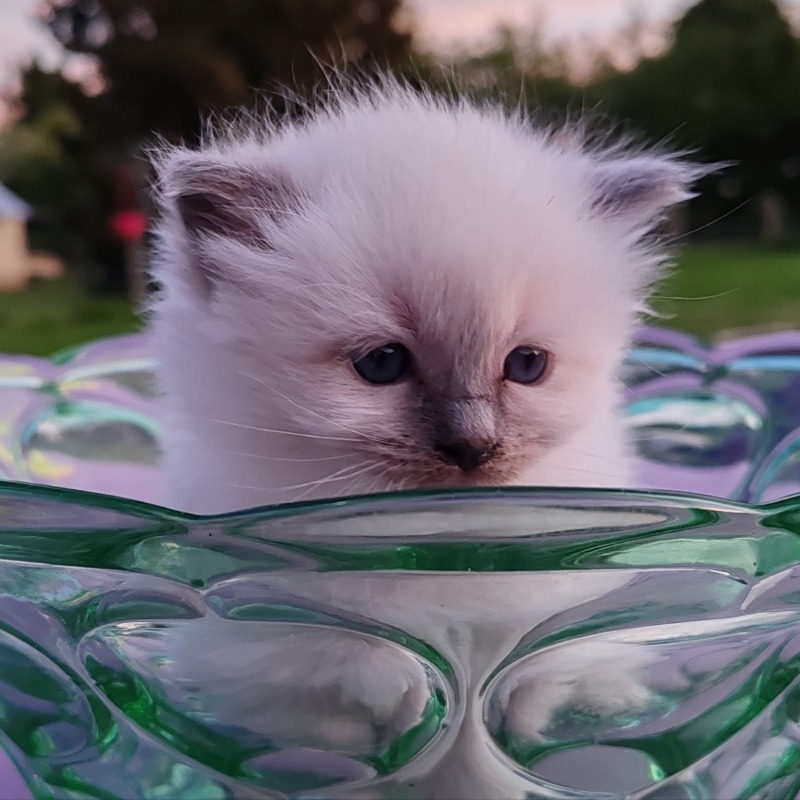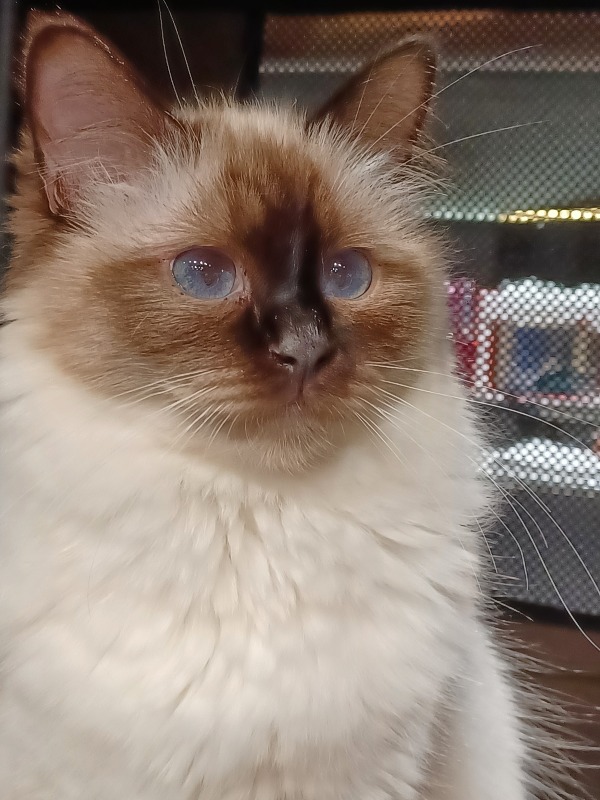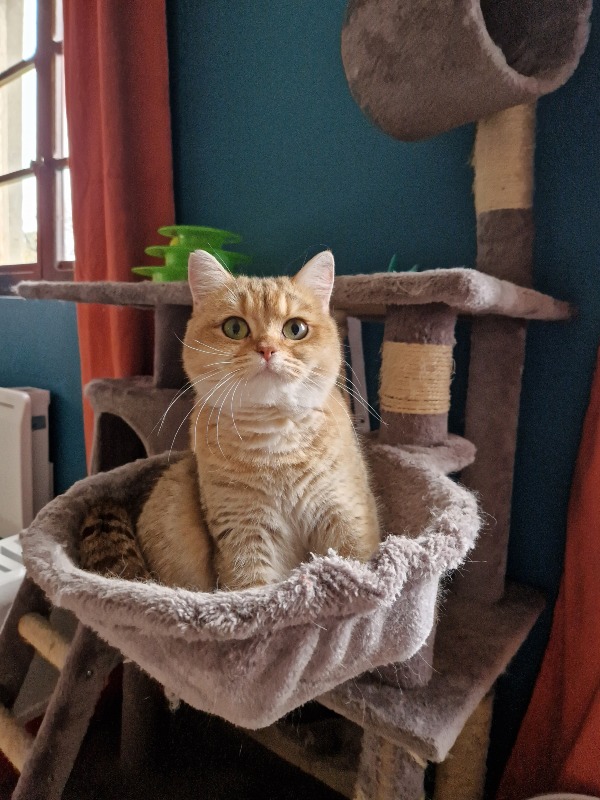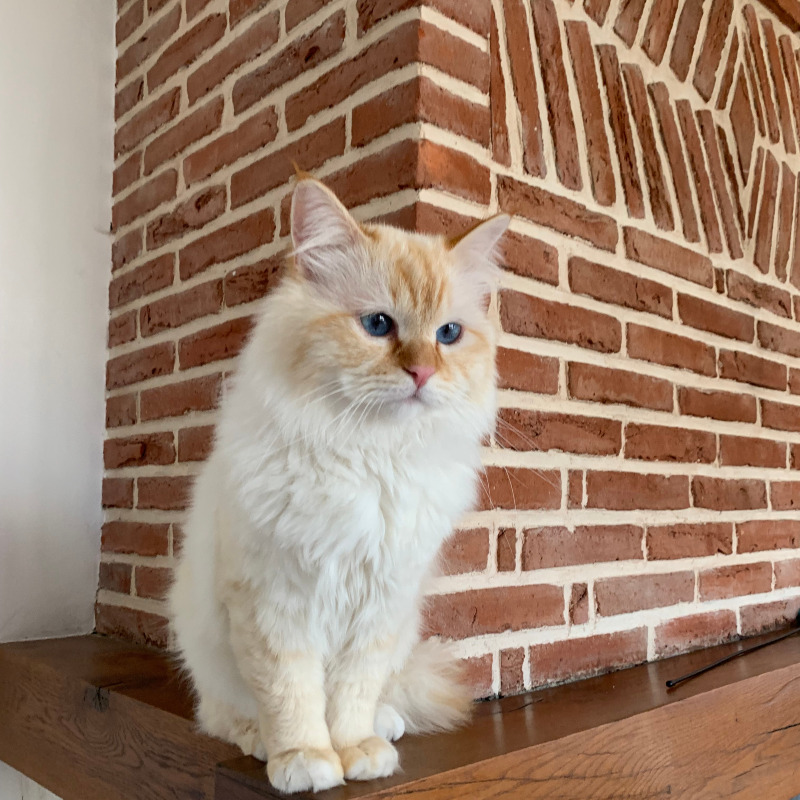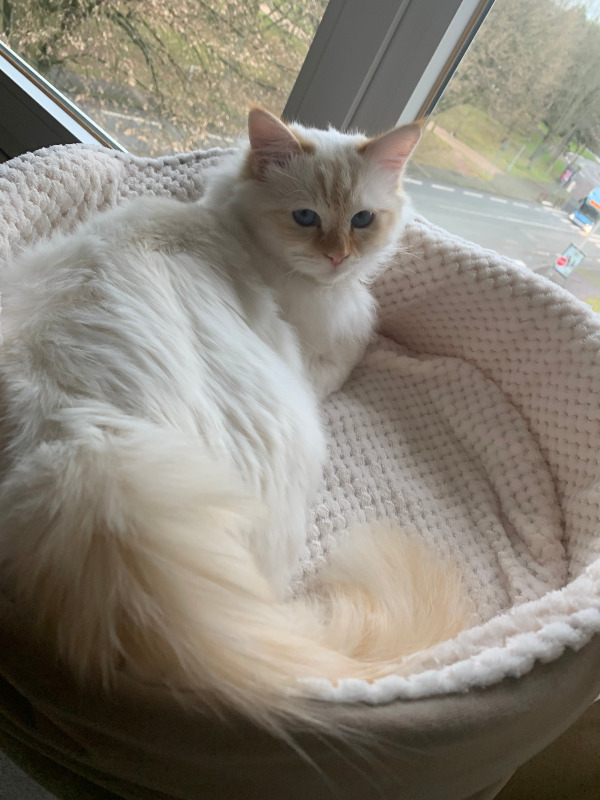Birman
Welcome to our page dedicated to the breed of cat birman!
Here, you will find all the useful information about birman. This descriptive profile will allow you to discover the aspects of this breed. You can notably consult information about the average price, monthly and annual upkeep expenses, their health, name ideas, as well as their official recognition by competent authorities.
Explore this page to discover everything you need to know.
Overall description of the breed
The Birman, an iconic and mysterious cat breed, has a deeply rooted history in the legends and mysteries of the Orient. Originating from Burma (now Myanmar), this cat is surrounded by fascinating myths and stories that add to its aura of grace and mystery. Also known as the "Birman" or "Birman Cat," the Birman has captured the hearts of people all over the world.
The history of the Birman is partly surrounded by religious legends. According to one of these legends, a group of sacred cats inhabited a Buddhist temple in Burma. These cats were the guardians of the temples and monks, and they were said to be the souls of deceased priests. One of the most famous legends tells that a Burmese goddess named Tsun Kyan-Kse bound the souls of the temple cats to a male cat named Sinh. Sinh's eyes were said to be as deep blue as sapphires, and he had a luxurious coat and a cream-colored mantle. This legend explains the unique combination of light-colored coat and blue eyes in the breed.
The modern history of the breed began in the early 20th century when two Birman cats named "Maldapour" and "Sita" were imported to France by travelers. These cats became the founding ancestors of the breed in Europe. In France, the first breed standard for the Birman was established, and its distinctive appearance was precisely described. The breed quickly spread across Europe and North America.
The morphology of the Birman is graceful and elegant. They are medium to large-sized cats with a well-proportioned and muscular body. Their coat is semi-long and silky, with shorter hair on the face. One of the most striking features of the Birman is their vivid and expressive blue eyes, which contribute to their mystical aura. The coat color can vary but is always associated with darker color points on the ears, face, legs, and tail.
The Birman's character is as exceptional as its appearance. These cats are known for their gentle, affectionate, and social nature. They are known to form close bonds with humans, making them loyal and devoted companions. Birmans are often described as "dog-like cats" because they tend to follow their owners, lie down beside them, and actively participate in family life.
In terms of measurements, the average weight of the Birman typically ranges between 3.5 and 5.5 kg. Male cats tend to be larger and heavier than females. In terms of size, the Birman averages between 30 and 40 cm at the shoulder.
The Birman breed has been officially recognized by many renowned cat organizations worldwide, including the International Cat Fanciers' Federation (FIFe), the American Cat Fanciers Association (ACFA), and The International Cat Association (TICA). The breed standard has been precisely established to describe the morphological and color criteria that make this breed a distinct and admired feline beauty worldwide.
In conclusion, the Birman is a cat breed that combines beauty, history, and personality. From its mystical origins to its elegant appearance and affectionate character, it embodies the fascination that humans have always had for cats. Thanks to its global popularity and well-deserved reputation, the Birman continues to charm cat lovers and remains an iconic breed in the world of cats.
Awareness of acquiring an animal
Each animal is a sensitive being, deserving love, attention and care.
When you choose to adopt an animal, you take on the responsibility of ensuring its health and well-being throughout its life.
To learn more about animal welfare, we invite you to consult our FAQ by clicking the button below:
Origins
The Sacred Birman, also known as the Birman, is a breed of cat whose origins are shrouded in mystery and legends. It is said to come from the sacred temples of Burma (now Myanmar), where it was revered by priests. These cats were said to be the companions of monks, and their distinct appearance was a gift from the gods in recognition of their devotion. In reality, the breed as we know it today was developed in France in the 1920s. The first specimens were obtained by crossing Persians and Siamese, in order to create a cat with the graceful features and silky coat of the Persian, combined with the piercing blue eyes and distinctive markings of the Siamese.
History
The modern history of the Sacred Birman begins in France at the beginning of the 20th century. In 1919, a couple of Birman cats were imported to France. Legend has it that these cats were a gift of thanks for the help given to a Buddhist temple. After the male died during the trip, the female, named Sita, gave birth to kittens, one of which became the founder of the breed in Europe. The breeding program was intensified after World War II to rebuild the breed, which had almost disappeared. The Birman was officially recognized in France in the 1950s and has since become popular worldwide for its beauty and gentle temperament.
Standard
The standard of the Sacred Birman breed specifies several distinctive characteristics. The Birman is a medium to large sized cat, muscular and well-proportioned. Its head is broad and round, with a slightly bulging forehead and full cheeks. The eyes are large, oval and deep sapphire blue. The ears are medium in size, slightly rounded and well spaced. The body is long and robust, with medium length legs and round feet. The tail is of medium length, well covered with fur. The coat is medium in length, silky and without dense undercoat. Color markings are present on the ears, facial mask, paws and tail, with a lighter colored body.
Physical characteristics
The Sacred Birman is a medium to large-sized cat, typically weighing between 4 and 6 kg for females, and between 5 and 7 kg for males. Its semi-long and silky coat is one of its most distinctive features, with a lack of dense undercoat that makes maintenance easier. The coat colors can vary, with points (ears, face, legs, and tail) coming in shades such as seal, blue, chocolate, lilac, red, and cream, as well as tabby and tortie variations. The body is always lighter, creating a harmonious contrast with the colored points. Its eyes are always of an intense sapphire blue, adding to its majestic appearance.
Character
The Birman is known for its gentle and affectionate temperament. These cats are generally very social and deeply attached to their owners. They enjoy company and get along well with children and other pets, making them excellent family companions. Birmans are intelligent and curious, but not hyperactive. They enjoy playing and exploring, but also resting peacefully next to their favorite humans. Their balanced nature makes them ideal pets for those looking for both interaction and calm. They often communicate with gentle meows and are generally very adaptable to various home environments.
Life expectancy
The life expectancy of the Birman cat is generally between 12 and 16 years. With appropriate care, some Birmans can even live beyond this average. Their longevity depends on many factors, including genetics, diet, regular veterinary care, and a stress-free environment. Owners should be mindful of their overall health, ensuring their cat receives regular check-ups and a balanced diet. In general, Birmans are robust cats, but like all breeds, they can be prone to certain specific medical conditions, making visits to the veterinarian all the more important to ensure a long and healthy life.
Exercise and activity needs
The Birman cat is an active cat who enjoys playtime and exploration. Although not as hyperactive as some other breeds, they still require mental and physical stimulation to stay healthy and happy. They love interactive toys, cat trees, and tunnels that allow them to climb, run, and jump. Play sessions with their owners are also important, as they strengthen the bond between the cat and human while providing necessary physical activity. Birmans are naturally curious and enjoy exploring their environment, so secure access to the outdoors, like a fenced garden, can be beneficial. However, they also adapt well to apartment living as long as they have enough toys and interactions to avoid boredom.
Recommended diet
The Birman cat requires a balanced and high-quality diet to maintain its health and silky coat. It is recommended to provide a combination of high-quality dry food and wet food specifically formulated for purebred cats or long-haired cats. Dry food should contain a good proportion of animal proteins, healthy fats, as well as essential vitamins and minerals. It is important to avoid foods containing too many cereals and low-quality by-products. The monthly cost to feed a Birman cat typically ranges between 30 and 60 euros, depending on the quality of the chosen foods and the specific needs of the cat. Regular monitoring of its weight and veterinary consultations will help adjust its diet if necessary.
Training and obedience
The Birman is an intelligent and curious cat, which facilitates its education and training. Although cats are generally less receptive to training than dogs, Birmans can learn simple commands, such as coming when called, through short and positive sessions based on rewards. Using treats and verbal praise is effective in motivating this cat. It is also possible to teach him to use a scratching post instead of furniture, to use a clean litter box, and even to walk on a leash. Socialization from a young age is crucial for him to get used to different people, animals, and environments. Birmans enjoy interactive games and can easily engage in fun activities that reinforce their education and positive behavior.
Behavior with children
The Birman is generally excellent with children due to its gentle and affectionate temperament. It is patient and tolerant, making it an ideal companion for young children. Birmans enjoy games and interaction, and they can be very playful with children, liking to participate in family activities. However, it is important to supervise interactions between young children and the cat to ensure that children learn to treat the animal with respect and gentleness. Teaching children not to pull the cat's fur or tail, not to disturb it when it eats or sleeps, and to handle it gently is essential for harmonious cohabitation. With proper introduction and appropriate boundaries, the Birman can become a wonderful companion for the whole family.
Compatibility with Other Animals
The Birman cat is known for its compatibility with other pets, including cats and dogs. Its sociable and friendly nature generally facilitates integration into a multi-pet household. Proper socialization from a young age helps the Birman adapt well to the presence of other animals and can even form strong bonds with them. However, it is important to introduce new companions gradually and in a controlled manner to avoid stress and conflicts. Initial interactions should be supervised and limited to short periods, gradually increasing the time spent together. Providing each animal with their own space to retreat is also crucial to prevent tensions. In general, with proper introduction and time, the Birman cat will coexist harmoniously with other pets.
Grooming needs
The Birman cat has a medium-length and silky coat that requires regular maintenance to stay in good condition. Fortunately, this cat does not have a thick undercoat, making grooming easier compared to other long-haired breeds. Brushing once or twice a week is usually sufficient to prevent knots and tangles. During shedding seasons, in spring and fall, more frequent brushing may be necessary to manage hair loss. It is also important to regularly check and clean the ears, trim the claws every two to three weeks, and maintain good oral hygiene by brushing the cat's teeth or using dental treats. An occasional bath may be necessary, but not frequently, unless the cat gets dirty.
Health
The Birman breed is generally robust, but can be prone to certain hereditary health conditions. Among the most common health issues are hypertrophic cardiomyopathy (HCM), a heart disease that can affect cats of all breeds, as well as polycystic kidney disease (PKD), which can lead to kidney problems. Birmans can also be sensitive to dental diseases, so it is crucial to maintain good oral hygiene. Regular veterinary check-ups are essential to monitor the cat's overall health and detect potential problems early. Balanced nutrition, up-to-date vaccinations, and parasite prevention also contribute to the health of the Birman. By taking care of these aspects, you can help your Birman lead a long and healthy life.
Average price
The average price of a Birman cat varies considerably depending on the lineage, breeder, geographical location, and quality of the cat (pet, breeding, or show). Generally, you can expect to pay between 800 and 1500 euros for a quality pet kitten. Show or breeding quality kittens, with exceptional pedigrees, can cost between 1500 and 2500 euros, or even more. It is crucial to choose a reputable breeder who conducts health tests on their breeding cats and raises kittens in a healthy and stimulating environment. While initial costs may seem high, they often reflect the care and attention given to breeding healthy and well-socialized cats. Be sure to also consider additional expenses for veterinary care, food, and necessary accessories.
Expenses
The monthly expenses for a Birman cat can vary depending on several factors, but on average, you can expect to spend between 50 and 100 euros per month. This includes the cost of high-quality food, which is typically 30 to 60 euros per month, veterinary fees for preventive care, vaccines, and antiparasitic treatments, which can cost around 10 to 30 euros per month on average. Other expenses include litter, toys, scratching posts, and possibly grooming fees if you hire a professional. Costs may increase if your cat requires specific veterinary care or treatments for particular health conditions. Budgeting for veterinary emergency situations is also a good practice to ensure that your cat receives necessary care in case of need.
Name ideas
Choosing a name for your Birman cat can be a fun and creative moment. Here are some suggestions to inspire you: Luna, Simba, Sapphire, Pearl, Isis, Oscar, Nala, Leo, Maya, Blue, Bella, Feline, Jasper, Milou, Zoe, Merlin, Bianca, Ebony, Nino, Arya, Tigris, Snowflake, Pixel, Opal, Felix, Caramel, Stella, Gatsby, Diva, Orion, Cookie, Misty, Venus, Nimbus, Topaz, Sushi, Jade, Mocha, Ruby. These names often reflect the physical characteristics and unique personality of the Birman, ranging from its striking blue eyes to its gentle and loving nature. Take the time to choose a name that resonates with you and fits well with your new feline companion.
Legislation and regulation
In France, the Birman cat is not classified among the breeds of cats subject to strict regulations or a particular categorization. However, it is important to comply with local laws regarding pet ownership, which include registering your cat with local authorities and keeping its vaccinations up to date. It is also recommended to microchip your cat to facilitate its identification in case of loss. Breeders must adhere to animal welfare standards and provide a certificate of good health and pedigree for each kitten sold. If you are considering importing a Birman cat from another country, make sure to know the quarantine requirements and health regulations in place to avoid complications.
Official recognition
The Birman is recognized by several international feline organizations. In France, it is recognized by the LOOF (Livre Officiel des Origines Félines). In the United States, the CFA (Cat Fanciers' Association) and the TICA (The International Cat Association) also recognize the breed. In Great Britain, the GCCF (Governing Council of the Cat Fancy) and in Europe, the FIFe (Fédération Internationale Féline) recognize the Birman. These organizations establish breed standards and organize cat shows where Birmans can compete for championship titles. Recognition by these organizations guarantees that breeders adhere to high standards of health and welfare for their cats, contributing to the preservation and improvement of the breed.
Pedigrees
Birman cats with pedigree are registered with recognized breed clubs. In France, the LOOF (Livre Officiel des Origines Félines) is the main organization issuing pedigrees. In the United States, pedigrees are managed by the CFA (Cat Fanciers' Association) and TICA (The International Cat Association). In Great Britain, the GCCF (Governing Council of the Cat Fancy) and in Europe, the FIFe (Fédération Internationale Féline) are in charge of pedigrees. These breed clubs ensure compliance with standards, health tests of breeders, and the genealogy of cats. Other notable clubs include the Birman Cat Club (UK) and the Club des Amateurs de Chats Sacrés de Birmanie (France). Pedigrees ensure that kittens come from controlled lines and meet breed criteria.
Destination and usage
The Birman cat is primarily intended to be a pet because of its gentle and affectionate nature. However, it also excels in cat shows where its distinctive traits and beauty are highlighted. Breeders focus on preserving and improving the breed's characteristics, often participating in contests to evaluate their cats against established standards. Birmans are also used in breeding programs to maintain the genetic health of the breed. Due to their balanced temperament and sociability, they can also be therapy animals, providing comfort and companionship to the elderly or patients in a hospital setting. The Birman cat thrives in loving homes where it can regularly interact with its owners.
Prohibitions
There are no specific prohibitions regarding the possession or breeding of Birman cats in France or in most countries. However, it is important to abide by local animal welfare regulations, including providing proper care, appropriate nutrition, and regular veterinary exams. Breeders must adhere to ethical and legal breeding standards, ensuring that kittens are raised in healthy and respectful conditions. The import and export of these cats must also comply with international regulations regarding pets, including the necessary certificates.
Breeders of Birman
Want to see more breeders of Birman?
Check out the page of our directory listing all breeders of BirmanClassified Ads of Birman
Breed clubs of birman
No of birman breed clubs are currently registered on Preeders.
If you would like to highlight your breed club, sign up for free now and be the first to appear on this page.

